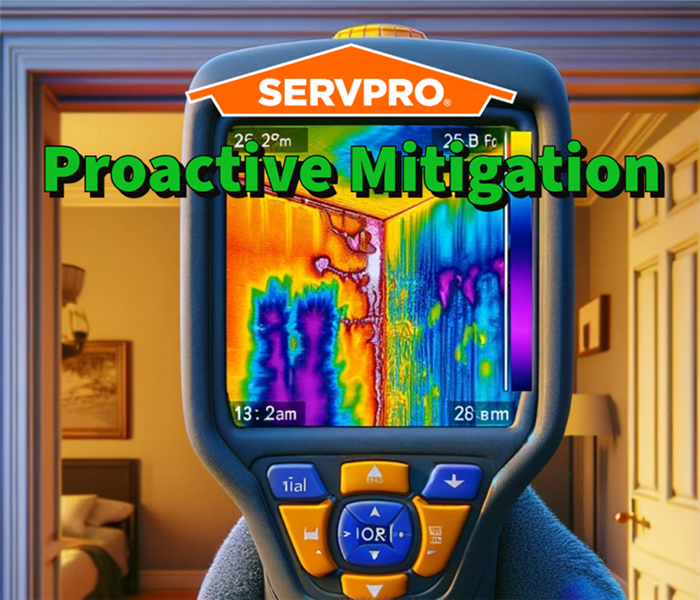Proactive Mitigation: 10 Strategies to Protect Your Property
4/29/2024 (Permalink)
Leveraging proactive mitigation to fortify residential and commercial properties against potential damages in Beavercreek, Ohio.
In the dynamic climate of Beavercreek, Ohio, where weather patterns can swiftly change, proactive mitigation becomes paramount for property owners. This comprehensive guide will outline essential strategies to prevent damage before it occurs, emphasizing the value of anticipation and preparedness in property management. Through a detailed exploration of proactive measures and a case study involving our SERVPRO® team, this post aims to equip property owners with the knowledge to safeguard their investments effectively.
Understanding Proactive Mitigation
Proactive mitigation refers to the preemptive actions taken to reduce or eliminate risks to properties before they manifest as emergencies. This approach protects the physical structure and significantly diminishes potential financial losses and operational disruptions.
Evaluating Risks in Beavercreek
Beavercreek properties face several risks, primarily due to:
- Seasonal Storms: Bringing heavy rain, wind, and hail.
- Winter Weather: Characterized by snow and ice, leading to ice dams and frozen pipes.
- Flooding: Particularly for areas close to water bodies or with poor drainage systems.
- Fire Hazards: From both natural causes and human activities.
Comprehensive Proactive Mitigation Strategies
Implementing the following strategies can profoundly impact the resilience of a property against common hazards:
- Thorough Inspections: Conduct biannual inspections of your property’s roof, foundation, plumbing, and electrical systems. Look for potential vulnerabilities that could lead to extensive damages if left unattended.
- Weatherproofing: Enhance the weather resistance of your property by installing high-quality insulation, using storm windows, and applying water-repellent coating to exterior walls.
- Landscaping Adjustments: Properly manage the landscape to ensure adequate water runoff. Use strategic planning to create windbreaks that can reduce the impact of heavy winds on your property.
- Advanced Monitoring Systems: Employ state-of-the-art sensors that detect early signs of water leakage, gas leaks, or structural weakening. Integrating smart home technologies can facilitate real-time monitoring and faster reaction times to abnormal conditions.
- Emergency Preparedness Kits: Maintain updated emergency kits with necessary supplies, such as water, non-perishable food, first-aid items, and manual tools. Ensure easy accessibility for all occupants.
- Community Collaboration: Engage with local community planning and preparedness initiatives. Collaboration can improve regional resilience and shared resources during widespread emergencies.
- Structural Enhancements: Retrofit older structures with modern materials and technologies designed to withstand various disaster scenarios, such as earthquake-resistant frameworks or fire-retardant building materials.
- Regular Maintenance: Keep all critical systems, such as heating, ventilation, and air conditioning (HVAC), in optimal working condition. Schedule regular cleanings and upkeep to prevent system failures that could exacerbate disaster situations.
- Training and Drills: Conduct regular training sessions on emergency procedures and evacuation plans with all building occupants. Practice drills to ensure everyone knows how to react when seconds count.
- Insurance Review: Regularly review and update your insurance policies to ensure adequate coverage for all potential risks. Understand what is and isn’t covered under current policies and adjust coverage to match your property’s evolving risk profile.
Case Study: Proactive Mitigation in Beavercreek, Ohio
Recently, SERVPRO was called to assist a Beavercreek business complex that had experienced recurrent flooding issues during heavy rainfall. The complex had suffered significant financial losses due to water damage affecting critical infrastructure and operational delays.
Proactive Steps Implemented:
- Upgraded Drainage System: SERVPRO overhauled the existing drainage system to enhance its capacity and efficiency in channeling water away from the building.
- Water Barriers: Temporary water barriers were installed in critical areas predicted to be most affected during storms.
- Regular Maintenance Checks: Set up a schedule for regular checks and maintenance of the building’s exterior and plumbing systems to identify and address issues promptly.
Outcome:
The modifications and upgrades implemented significantly mitigated the impact of subsequent storms. The business could continue operations uninterrupted, and previous damage areas remained dry and secure. This proactive approach saved the business from further financial strain and strengthened its reputation as a resilient and proactive institution.
Embrace Proactive Mitigation with SERVPRO
In Beavercreek and beyond, being proactive about property risks is more than a precaution; it’s a strategy that preserves the integrity and value of your property while ensuring the safety of its occupants. SERVPRO offers comprehensive risk assessments, implements advanced mitigation strategies, and provides rapid response restoration services. Our proactive measures equip property owners to handle potential disasters confidently, minimizing damage and associated costs. Trust SERVPRO to be your expert partner in protecting your property through proactive mitigation.



 24/7 Emergency Service
24/7 Emergency Service